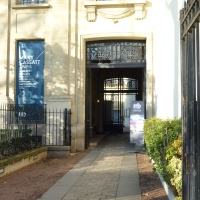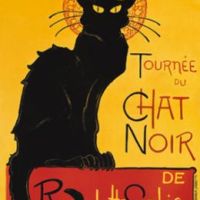Here we are at the intersection of the rue St-Jacques and the boulevard Port-Royal (aka Carrefour de la Mort – our name for it; you won’t see it on the walls!), heading south. Once you have crossed the tricky intersection, the street name becomes rue du Faubourg St-Jacques. In crossing the intersection, you have crossed the site of one of the city’s former walls.
Look for a big blue door on the right. That is the old entrance to the Port Royal Maternity Hospital. The convent buildings with their cloister and garden are still there and still beautiful, although the maternity services are provided in a modern building. Note the plaque on the wall to the right of the door, facing the boulevard, indicating that in the First World War, one of the shells from the huge German cannon fell near this spot, killing 20 people in the hospital.

Further down the street, on the left, you will see the entrance to yet another hospital: the Cochin. I mentioned the Abbé Cochin last time. He would not recognize his own creation in this huge modern hospital, with its campus of buildings and internal streets taking up most of the block.
On the right, the rue Cassini reminds you that you are a stone’s throw from the Observatoire. The street is named for the 17th-century Italian-born astronomer Giovanni Domenico Cassini. The name lives on in Cassini’s laws of the rotation and orbit of the moon, an asteroid, a lunar crater, a Martian crater, and a space probe that orbited Saturn. That’s just a sample of things astronomical named for him.
Down a bit on the right you will see the entrance to the Hôtel de Massa. The gateposts bear the name “Société de Gens de Lettres,” an organization founded in a house on the Champs-Elysées by Honoré de Balzac, Victor Hugo, George Sand, Théophile Gautier, and Alexandre Dumas, among others. The house was dismantled stone by stone and rebuilt here in 1929. Now it is used as an event space as well as offices for France Festivals.

The day I wandered into the gates, I was told that the house was open only on Jours de Patrimoine, but that I was welcome to explore the gardens, which are large and attractive, and shady in summer. So I did.

The society’s website shows interior views of the building, filled with light. I could move in tomorrow.
On the other side of the street a bit farther down is the convent of the Sisters of St. Joseph of Cluny, one of several surviving convents in this area that was once covered with monastic establishments. It is not open to the public, but if you go past it and look back from the Boulevard Arago, you can see its tall chapel over the high surrounding wall.

The boulevard Arago is also where the long wall on the right side of the street gives way to an iron fence and you can look in at the gardens of the Observatoire. This area is filled with walled gardens, and I have been known to go to great lengths to get a look at some of them. Sometimes you can go into a commercial building and look out its back windows into the garden. Occasionally a door is left open, in which case, we walk in (we can always apologize and retreat if we are challenged, but we will have seen something in the meantime), but so much is hidden and you’d need a drone to get a good view.
To the east down the boulevard Arago is the grim Prison de la Santé (the prison may not contribute to anyone’s health, but there was once a hospital here, hence the name), in front of which is the last remaining Vespasienne in Paris. You might or might not want to make a detour to see it.
Probably better to carry on down the route of St-Jacques. On the southeast corner is the Protestant Institute of Theology. Despite its dry-sounding name, it clearly employs some creative and whimsical people. Once we were passing with some friends and saw a sign on the door inviting us in. The little front garden inside the wall was filled with artwork made from found objects. We went inside to see more displays. In an interior courtyard the artists themselves were at work, drawing from a pile of random objects spread out on the ground. Protestant theologians have some delightful pastimes, it seems.


A short walk father on and the road opens out to a boulevard, here called the boulevard St-Jacques, with the Metro going down the middle. This is where line 6 emerges from underground on its journey east; later it heaves itself farther upwards and becomes an overhead line, with a great view of the surrounding streets. The old-fashioned entrance has Hector Guimard’s Art Nouveau typography on the signs.
To this point, I have walked a route I know by heart, since we take this route to the metro stop so often. In forging ahead, I need to consult the map and the reference books.
The first thing to note is another change in the name of the street, to the rue de la Tombe-d’Issoire, one of Paris’s odder street names. It supposedly commemorates the legend of a giant who was killed near here. Or not.
Jacques Hillairet, my go-to guy for Paris streets, says in his Dictionnaire Historique des Rues de Paris that according to one tradition, Issoire (or Ysoré) came from Coïmbre in Portugal sometime in the Middle Ages (dates differ), was 4.5 metres tall (more than 14 feet), and menaced the Parisians, brandishing an axe, and demanding one-to-one combat with a worthy opponent (sounds like Goliath). Not surprisingly, there were no takers. King Louis (Hillairet doesn’t know which one) called upon a former Crusader called William of Orange, who had taken up residence in a hermitage in the south of France. William was reluctant to leave the hermitage, and at first told the king’s messenger that William of Orange was dead in order to get him to go away. Presumably the messenger was persistent, because eventually, William caved in, blew the dust off his old armour, and trundled north. He met the giant on the field of battle, dispatched him with a blow to the throat, and cut off his head. After the victory, William trundled home again, slammed the door on his hermitage, and refused all further invitations to venture forth.
Hillairet, who is nothing if not thorough, provides other theories about the street name, none of them quite as colourful. He says that the whole tale may have been retrofitted to suit the occasion in the 13th century when a very large and very old tomb was discovered on the route to Orléans, a tomb that may have dated back to Roman times. Hillairet notes another tradition: that Ysoré was a fearsome bandit who was killed in a nearby quarry where he was hiding. And another that the name Issoire belongs to a Parisian family who owned something called the “fief de tombes.” Or maybe it commemorates a citizen called Isaure who was buried nearby. Take your pick.
The first part of the rue de la Tombe-d’Issoire is unremarkable. The domed church named for St-Dominique is reflected in the glass of the office building opposite. An overpass carries the RER line B2 between Denfert-Rochereau and the Cité Universitaire.

Cross the tree-shaded avenue René Coty, which runs south to the Reservoir Montsouris (which we will see from a different angle farther on) and the pretty Parc Montsouris. The road widens a bit, and here and there are the glimpses of countrified Paris that one often finds in the 14th, such as the little two-storey house tucked into the intersection of the rue de la Tombe-d’Issoire and the rue Bezout.
At number 69-71, an archway gives you a glimpse of a courtyard and interior street. Just beyond, a more modern building offers another glimpse of a garden beyond.
On the left, you will see the brick of an elementary school. For a while, this school was decorated with a huge sculpture of the giant Issoire, looking wary, as well he might.
He must have brightened this corner of the intersection with the rue d’Alésia. He’s gone now, alas.
The road continues, over a cobble-stoned section with narrow lanes leading off on the left. Many of these little private or semi-private streets are called “villas,” such as the Villa Hannibal and the Villa Seurat. On the latter, note the lovely Art Deco building on the corner. The huge north-facing windows indicate a studio within.

On our walks, I tend to detour down these streets, if they are not blocked off by a gate. There is always something to be seen.
Past the last of the apartment blocks on the left, the view over an ivy-covered wall provides a glimpse of the reservoir Montsouris. Finished in 1874, and one of five reservoirs serving the city, it might seem to be a purely utilitarian water holding tank. But a photograph of the interior shows a water palace.
The outside is also decorative. We took this photo from the other side on a walk around Montsouris.

It’s not unlike the 1930s-era water palace near us in Toronto, the R.C. Harris Water Treatment Plant, which features a brass and marble interior and Art Deco stonework outside. People used to take pride in public works and make them beautiful.
Note the Wallace fountain in the courtyard just past the reservoir.

Past the playground is a very modern building on the left. This is the Jourdan campus of the Ecole Normale Supérieur / Paris Sciences et Lettres, a teacher training establishment. The school retains a historic building near the Panthéon. On the other side of the street is a recently completed student residence slashed diagonally by a long staircase. The windows have red coverings on the outside. I wonder how the residents raise and lower them. And whether anyone really uses the staircase.
Continue to the boulevard Jourdan, where trams glide by on tracks in a grassy right of way. Turn right. We’re nearly there.
The walk ends at the Porte d’Orléans Metro stop on the boulevard Jourdan. Traditionally, pilgrims left the city by the Porte d’Orléans. There’s a café on the corner where you can rest your feet.
Text and original photographs by Philippa Campsie; additional photographs from Google Street View and Wikimedia.




























I love these detailed guides! Like you, I never tired of walking those streets – always something new to discover. As a fellow Torontonian and Parisophile, it’s a pleasure to read about my favourite city when I cannot physically be there. Hope to bump into you one day in Paris or Toronto.
Hope so. Even “walking” down a street with Google street view can give me a taste of Paris!
Thank you, again!! And, I just spent all morning on google street views!! A little frustrating, but fun.
God bless, C-Marie
So glad you enjoyed the virtual walking tour!
A delightful read. Probably the only way I will “see” Paris is through your lovely Parisian Fields. Please keep up the good work. Please say Hello to Norman for me. Dawn Monroe
Thank you so much. Norman says hello too.
That was a very detailed tour – I loved the statue of Issoire – he looks like he could fall off the little ledge.